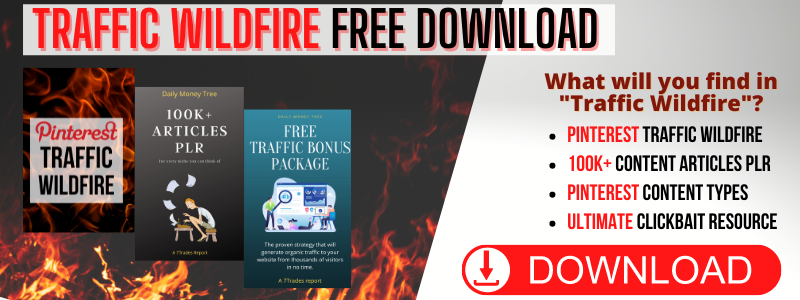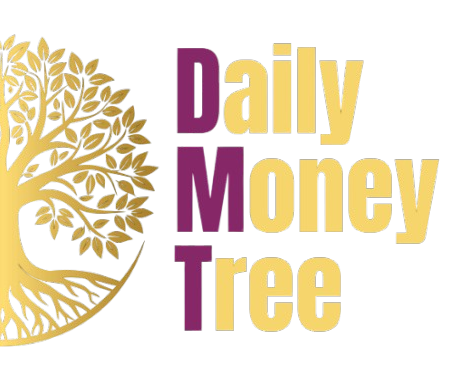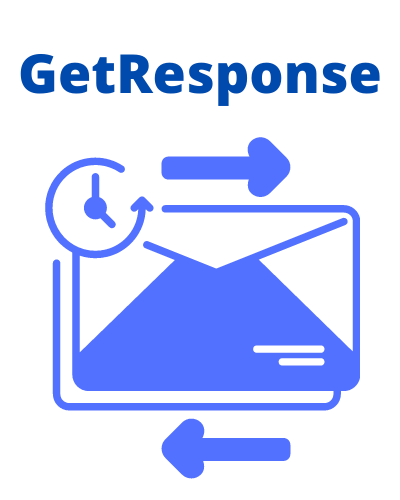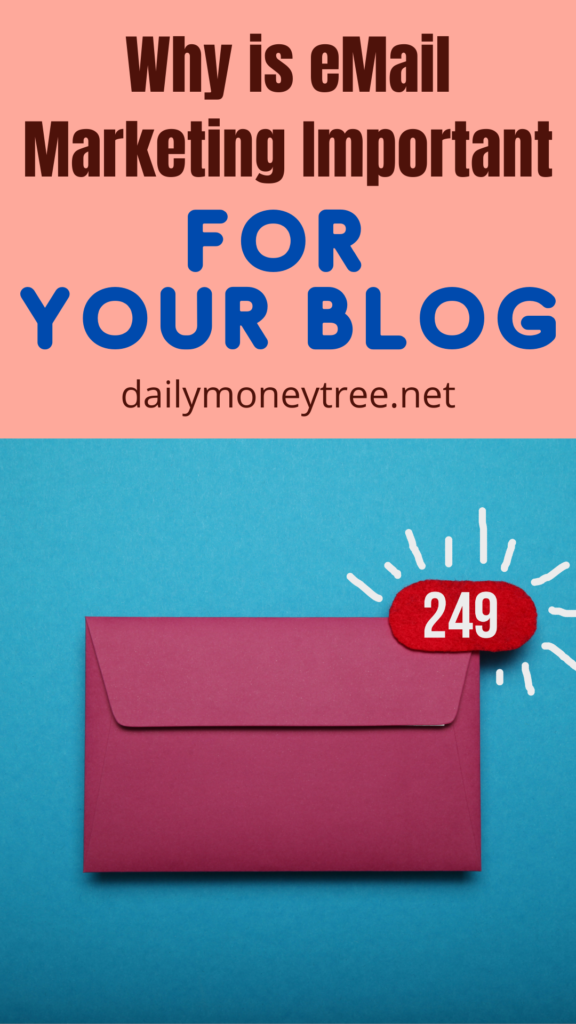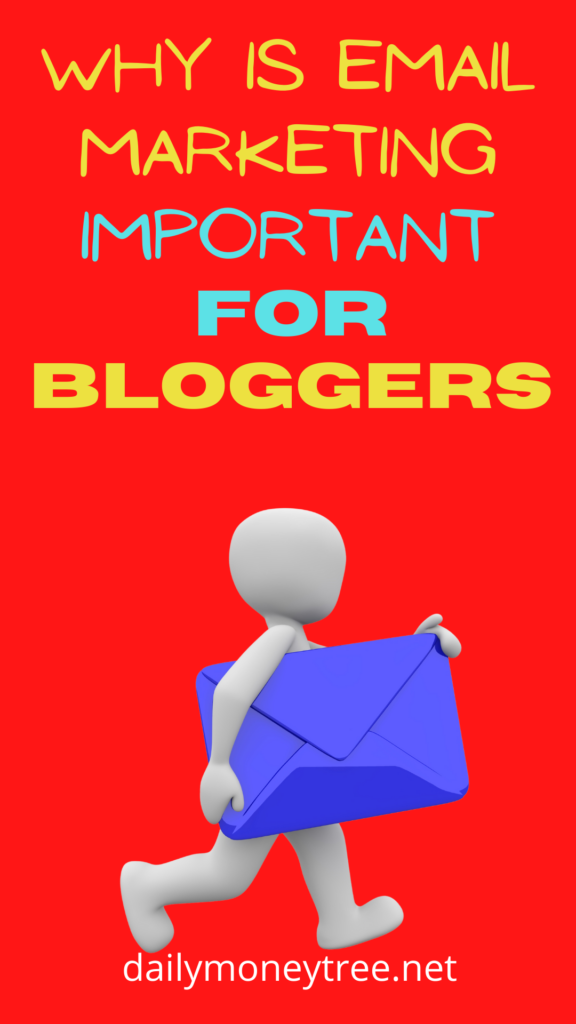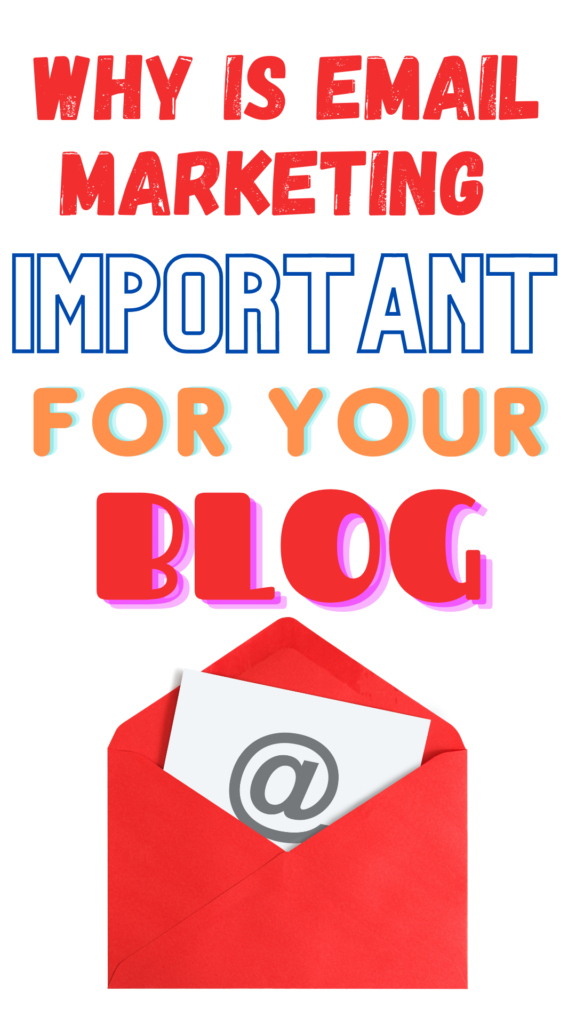So, why is email marketing important for your business or your blog? If you have a blog, or any kind of online business, email marketing is still a powerful tool for generating traffic and monetizing your work. Here’s how to create the best strategy
If you are thinking of creating a blog, or if you already have one that you would like to monetize, email marketing is still today one of the most valuable tools you have available.
Did you know that a blog without an effective email marketing strategy behind it is a blog destined to fail?
So email marketing isn’t dead, as some marketing gurus claim? Absolutely not, email marketing is alive and well (and is also doing the due diligence).
For years it has been repeated like a mantra that “The money is in the list”. And this sentence is still damn true. Can you believe that 80% of the revenue from my blogs comes from email marketing?
Your list is therefore undoubtedly one of the most important elements when it comes to monetizing a blog and in the course of this article, I will also explain why.
There are many types of email marketing. Here I want to deepen the one closest to what I do, namely email marketing for bloggers.
What do you say, do we want to throw ourselves into this new adventure? So let’s go!

What is (and what it should not be!) Email marketing
First of all: what exactly is email marketing?
Email marketing is simply a form of digital marketing that is carried out by sending emails.
Through email marketing, you can therefore inform your readers of the publication of new blog articles but also promote your products and services and – last but not least! – build stable and lasting relationships with them, based on mutual trust.
I particularly want to emphasize this point because, for many marketers, the newsletter has become a way to exclusively send their offers. No relationship with users, no replies to the writer.
Only a continuous “buy buy buy” before the offer ends / there are only 0.5 seats available / at the price of $ 1,834,924 only for today $ 0,02 VAT included / if you do not take the offer you will lose it forever and you’ll be the only loser in this world!
Be careful though. This is not to say that you shouldn’t promote your business and use marketing techniques.
I’m just saying that in my opinion, building and cultivating relationships is much more important than selling at all costs.
This is also the purpose of the birth of the web: to build relationships, to connect people with each other.
There are mainly 3 types of emails that you can send through email marketing:
- Informative emails, through which you can provide your readers with new content, news, promotions and offers
- Transactional emails, i.e. automatic emails that are sent to confirm an order, send an invoice or inform that a product has been shipped
- Behavioral emails, i.e. emails that are activated after a certain user behavior.
It is important that these types of emails coexist, in order to provide your users with the best possible experience. We will see in a moment how to create them.
Now you are probably wondering: why is email marketing so important? Isn’t blogging alone enough? Isn’t it enough to promote your content on social networks?
So let’s dissolve these doubts.
Why all bloggers should build a solid email marketing strategy
If today I were forced to choose whether to keep my blog open and completely lose my contact list or keep my contact list and destroy my blog, well, I would definitely choose to keep my list.
If you have an online business, be it a blog, e-commerce, or a simple showcase portfolio, you should seriously consider creating a solid email marketing strategy or optimizing the one you already have if it is not bringing you the results you want.
But isn’t blogging enough? If a person is interested in your content, he will regularly come back to your blog to see if there is something new, or not?
Um… no, not exactly.
There is a fundamental difference between email marketing and blogging, just as there is between email marketing and social media.
Through the blog you can attract new readers, create an online presence and show your skills, your products, and your services. On social media, you can promote your content. But that’s not enough for people to come back to you.
In fact, your mailing list – your contact list – is the only traffic you have. Think for a moment if Facebook, Instagram closes tomorrow, or if you have problems with your website server. Or maybe a change of the Google algorithm and you would find yourself without traffic in an instant.
Your contact list is the only thing you have left. And it would be enough for you to send a single email to reach all your readers again. This is why email marketing is important for your business.
Email marketing is, therefore, such a powerful tool because it is in effect a direct channel between you and your audience, a channel that you own, that belongs to you, and that you can control directly.
The BLOG + EMAIL MARKETING combination is therefore a very powerful tool to drive regular traffic to your content, build stable relationships and make money with your blog.
As the number of people on your list increases, you will also increase the pool of users interested in your products and services, thus increasing your chances of monetization.

What are the (real) advantages of email marketing for a blog?
So what are the tangible benefits of building a solid email marketing strategy?
- Email marketing is the only way to get the traffic you own
- It is a direct channel between you and your readers
- If people sign up for your mailing list, it means they are interested in what you offer. This means creating a list of people who are profiled and who have shown interest in your content, products and services
- You can use the mailing list to request feedback and optimize your work, conduct market research in a specific niche and validate your ideas before putting them on their feet
- Email marketing has an average return on investment (ROI) of $ 55, which is a profit of $ 55 for every $ spent
- It is very easy to use: just write your email and send it to reach all your contacts with a click
- Strengthen your branding, increase your authority and allow you to create stable and lasting relationships with your users
- It is a measurable and scalable tool
- You have the ability to segment your audience (for example with the tools that GetResponse offers you) and offer each of your users a personalized and relevant message, delivering it at the right time in their customer journey
- You can create automatic email sequences: welcome email, a reminder for the abandoned cart, birthday wishes and so on
- You can get a complete overview of who has bought, who has bought multiple times or predict who is ready to do so
- It allows you to monetize your blog in a much easier and much more effective way
- You can get constant traffic to your website by promoting new content or old updated articles
- You retain your audience by offering them extra content, special bonuses, incentives, discounts and thus increasing your conversions
- You can ask your followers what difficulties they are facing and what results they want to achieve, so as to get new ideas for your blog articles or ideas for the best products to offer.
Words to know
When we interface for the first time with the world of email marketing (but also of all-around digital marketing) we often come across words, acronyms, and acronyms with obscure meanings.
I still remember my demoralization when, at the beginning of my career, I found myself following courses and reading guides that took for granted words and concepts that for beginners are anything but obvious.
Here is a list (not definitive!) Of the most used words in this field, with their meaning.
Automation
It is an email or a sequence of emails that are sent automatically when certain conditions are met.
For example, you can create a series of 10 emails that are sent automatically from the moment you sign up for the newsletter every 24 hours from each other.
This is the case, for example, with my free course on how to create a blog. As soon as you sign up, you will automatically receive a welcome email and an email a day for 7 days where you will find 7 different lessons of the course, always automated.
Bounce rate
This is the percentage of email addresses on your list to which mail is not delivered, often because it is rejected by the recipient’s mail server.
There are 2 types of bounces:
- hard bounce, which is a permanent problem, such as an email address that no longer exists
- soft bounce, usually temporary and indicating a “milder” problem, such as an offline server or the recipient’s mailbox full.
CTR (Click through rate)
It is the percentage of people who have clicked on at least one link in the email.
For example, if the CTR is 30%, it means that 30% of the people who opened the email clicked at least one link.
CTA (Call to action)
The CTA, or call to action, is an invitation for our reader to take a certain action, such as buying a product, clicking on a link, downloading a resource, and so on.
Deliverity rate
This is the percentage of messages that are successfully forwarded.
Double opt-in
The double opt-in was very popular a few years ago even if over time it has partially lost its effectiveness. This is a two-step email address confirmation process, so as to prevent users from signing up with fake emails.
In practice, people sign up for the newsletter by entering their email and receive an email through which they must confirm their email address, usually by clicking a button or link.
Only after confirmation, will they actually be subscribed to the list and will start receiving our content.
Transactional emails
Transactional emails are automatic messages that are triggered by specific actions of a user. Some examples of transactional emails are welcome emails, shipping notifications, order confirmation, and so on.
You can easily create them with email marketing tools such as GetResponse, my favorite.
In fact, by clicking on the link, or the image below, and becoming a member, you get a $25,00 credit!
Funnel
A funnel is a path designed for the user to guide him through a purchase by sending informative emails.
My favorite funnel builder is Groove Funnels. Apart from having more features than you will ever use (at least I don’t), it offers LIFE-LONG FREE MEMBERSHIP, unlike any other funnel builder which you usually have to pay $99/month.
Open rate
The open rate is an important index of the satisfaction of your emails.
It is in fact the percentage of people who have actually opened your message. Usually, to be considered good, the open rate should not fall below 20-25%.
Segmentation
An important thing when you have a contact list is segmentation, i.e. segmenting, dividing users based on specific criteria.
For example, if you offer offline events, it may be important to segment your contacts based on their place of residence so as not to send those who live in Milan an invitation for an event to be held in Palermo.
There are many ways to segment your audience, such as demographic characteristics but also the number of visits to your blog, purchases made, paths and funnels completed, and so on.
Spam
Spam (or junk mail, literally junk email) are emails that are reported as unwanted. If your emails do not follow precise quality standards, they can risk being reported as spam and ending up in the junk mail folder.
This is why it is important to establish lasting relationships with your users, offer them valuable content and not send any type of annoying or “spammy” message.
Tag
Tags are labels that you can insert into your contacts to segment them and create their personalized paths.
For example, you can put the “customer” label when making the purchase, based on his interests, “free trial” after he has tried your product for free, and so on.
Why is email marketing important for your business – How to create an email marketing strategy

In light of what we have seen so far, we can therefore group the objectives of email marketing under 3 broad categories:
- Retain our users
- Generate traffic to our blog
- Monetize our website.
It goes without saying that to achieve these goals it is important to create a clear and effective email marketing strategy.
Let’s see how.
Identify your goals
Seneca told a great truth:
There is no favorable wind for the sailor who does not know where he’s going.
If you don’t know which direction you’re going, it’s virtually impossible to get on the right path. If, on the other hand, you have a clear goal, the direction is clear as the sun.
And to choose the right path you will have to do some tests.
The first step in creating an effective email marketing strategy is therefore to write down the goals you want to achieve.
Don’t try to sell something on the first email right away. Grow your list regularly and naturally, always offering valuable content.
Create personalized and tailored paths that lead the user to the goal you want to achieve.
Always keep an eye on these results:
- Growth of the list. If a lot of people unsubscribe after a handful of emails, you probably need to give your content a good review.
- Consider that you will always lose someone along the way: maybe they are no longer interested in the topic or change their email address. Don’t take it personally.
- The involvement. Create relationships, always reply to emails (if you have little time to do it, look for someone on Fiverr who can do it for you)
- Gradually increase conversions by constantly optimizing what works in your strategy and eliminating what doesn’t bring results.
Create a strategic action plan
Now that you’ve determined your goals, you can start building your email strategy.
Think about the goals you have identified. What is the best way to reach them? Who are you writing to? What are your doubts, your fears, your desires, your interests? How can you help him achieve his goals?
With these answers, make a summary plan (maybe even create a plan B) and put it into action.
A few tips to do this:
- Those who subscribe to your newsletter probably don’t know you yet. This is why we usually send a welcome email, that is a welcome email in which we briefly summarize who we are, what we do and why we do it.
- A person who does not yet know you will hardly buy anything from you cold. It is therefore important – as they say in technical jargon – to warm the lead, that is to offer him valuable content so that he can learn to trust us and our products or services.
- Create ad hoc paths, segmenting your leads. For example, if you sell animal food, try to understand what type of animal each person has so that you always send them relevant emails. If he has a dog, instruct him on dog nutrition and send him offers on dog food. In fact, if he receives emails about turtles, he will soon stop opening your emails.
Choose the best email marketing service
There are tons of email marketing (ESP) services. The best in my opinion in terms of functionality/price are:
Personally, at one point or another, I have used all these tools in my daily life in different projects, although my favorites remain:
- GetResponse, a tool that offers you much more than just sending emails at a more than competitive price
- ActiveCampaign, which allows you a capillary segmentation and the creation of incredible funnels.
Both of these tools allow you to create effective sales funnels, transactional emails, automation and allow you to always send the right message at the right time.
Grow your list
We have identified our goals, created a first summary plan, and chosen our email marketing tool. And now?
Now it’s time to grow our list.
The simplest way to acquire new contacts is to create forms on our blog where new subscribers can leave their emails and which are called opt-in forms.
When you ask for something, however, it is always recommended to donate something in return.
For this reason, something is very often offered in exchange for an email. It can be free extra content, a PDF, a discount coupon, a giveaway, or whatever you want.
Create a welcome email for your new subscribers

A very important email for all new subscribers is the so-called welcome email, which is the welcome email.
In fact, imagine entering a site you have never seen before. They offer you a very interesting resource to download or a discount coupon, leave your email to get your bonus and it all ends there.
After a while, you will start receiving emails from that site and you don’t even remember who they were or why they have your email.
And you will discriminate yourself.
If you don’t want it to happen to your contacts when you send them your emails, it’s essential to create a connection right away. In the end, communication on the web should never be too different from a real conversation, except for the fact that we are not physically in front of each other.
Increase the open rate of your emails
Think about your inbox for a moment. How many emails do you receive each day?
Personally, I receive hundreds of them every day from the newsletters I subscribe to, and objectively, it is impossible for me to read them all. I don’t have to do anything else all day to do it.
So, how do I know if an email may be of interest to me – and therefore worth opening? Exactly, the subject line.
Very often we tend to forget the importance of this short line of text when in reality it is one of the fundamental elements for a successful email marketing strategy.
The subject of the email must therefore be concise, convincing, able to generate a sense of urgency but at the same time managing to transmit sufficient information to make it possible for those who received the email to understand if the content may be relevant to them or less.
Doesn’t sound easy, does it? And in fact, it is not really a very simple thing and the risk of falling into spam is always around the corner.
So how do you go about creating a captivating subject line? Here are some tips:
- Avoid spam
- Stay between 30 and 50 characters
- Use numbers, symbols, and emojis
- Avoid capslock and write everything in lowercase
- Personalize your subject lines, perhaps by entering the recipient’s name (you can do this easily through GetResponse or ActiveCampaign)
- Focus on the benefit they can get from reading your email rather than the content of it
- Aim to instill curiosity
- Do A / B tests to figure out which subject line receives the most openings
Monetize your list
We have done a great job so far. Now it’s time to monetize it, which is the #1 reason why email marketing is important for your business and your blog.
And if you have followed these tips to the letter and have managed to establish a deep connection with your contacts, then you will also have a better chance of making good money.
And how much are these earnings? It depends on many things: your ability to forge relationships, your product, your service, and your niche.
Monitor the results and optimize the strategy

If you thought that sending your email was the point of arrival, I have bad news for you: this is just the beginning.
In fact, now comes a very important phase: that of the analysis of results and optimization.
Analyze reports carefully – all major email marketing services like GetResponse and ActiveCampaign allow you to do this.
Optimize not only the content but also the layout of your emails. Both of the tools I have suggested also offer a wide choice of layouts and templates that you can use.
Optimize your CTAs trying to limit them to one, a maximum of two, for each email, and conduct A / B tests to constantly improve your work, push on what works and improve what doesn’t bring results.

GDPR
A small note on the GDPR, a very important topic for those dealing with people’s private data, such as the email address.
The GDPR is a very vast and complex topic that I do not want to deepen here but it seems only right to spend a few words on it.
Meanwhile, what is the General Data Protection Regulation (GDPR)?
This is a series of laws approved on April 14, 2016, by the European Parliament and which have as their object data privacy throughout Europe.
These regulations require that each user must have given explicit and free consent to receive your emails. If it doesn’t and you sign it up on your mailing list, you can be in trouble.
All these consents must be kept with care. You can also do this very easily using email marketing tools like GetResponse.
Why is Email Marketing Important For Your Business and Blog – Conclusion
Here we are at the end of this long and hopefully interesting journey into the world of email marketing. I hope that I have succeeded in explaining why email marketing is important for your business and your blog.
We have seen how email marketing is still such a powerful tool not only to generate revenue with your website but also to create a close-knit community around our content and to create stable and lasting relationships with our audience.
One last tip before saying goodbye. When we start working on a new contact list, we don’t always manage to generate revenue right away. It takes time, patience, and perseverance.
Keep delivering content, giving before you demand, really listen to your audience, and don’t stop optimizing your content and campaigns. Only then will you realize that the results will not be far away.
To your success!
S
